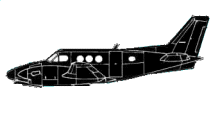
ASN Wikibase Occurrence # 299040
This information is added by users of ASN. Neither ASN nor the Flight Safety Foundation are responsible for the completeness or correctness of this information.
If you feel this information is incomplete or incorrect, you can submit corrected information.
| Date: | Friday 5 May 2000 |
| Time: | 09:15 LT |
| Type: |  Beechcraft 90 King Air |
| Owner/operator: | Aerospace Equipment Research Organization |
| Registration: | N32229 |
| MSN: | LJ-49 |
| Total airframe hrs: | 11749 hours |
| Engine model: | Pratt & Whitney PT6A-6 |
| Fatalities: | Fatalities: 0 / Occupants: 4 |
| Aircraft damage: | Substantial |
| Category: | Accident |
| Location: | China Lake, California -
 United States of America United States of America
|
| Phase: | Unknown |
| Nature: | Unknown |
| Departure airport: | China Lake, CA (KNID) |
| China Lake (KNID) | |
| Investigating agency: | NTSB |
| Confidence Rating: |
The twin-engine airplane experienced a loss of control after becoming entangled with a deploying parachute during cruise flight at 20,000 feet and 180 knots. The test flight was conducted to test an experimental parachute with a 331-pound anthropomorphic dummy that was rigged to the parachute. Two crewmembers in the airplane's cabin were to push the dummy out of the door and the parachute would deploy by pulling on a static line that was secured to a floor seat track. The static line for this flight had been reduced in length from 14 feet to 9 feet because of a previous test flight where a pin on the end of the static line became entangled with the elevator hinge and caused control problems. With the shortened static line, it was in tension when the dummy was positioned in the doorway. During the accident flight, once the dummy cleared the doorway, the static line deployed the pilot chute which in turn deployed the drogue chute. The drogue chute cleared the top of the left horizontal stabilizer while the dummy fell below. The dummy began oscillating and impacted the empennage and lower side of the horizontal stabilizer, eventually resulting in the partial separation and bending down of the stabilizer about midspan. As the dummy became entangled on the left horizontal stabilizer, the airplane made an uncommanded nose over into a negative G arc, which threw one crewmember about the cabin while the second crewmember was able to restrain himself by holding onto the static line. As the main parachute deployed, the drogue chute lines separated and the dummy and canopies fell away from the airplane. As the dummy fell away, the airplane pitched up and began an uncommanded roll to the right, stopping in a fully inverted attitude. The airplane initially nosed forward and then began a slow roll to the left, eventually stabilizing in wings level attitude. The pilots then returned the airplane to the airport and landed without further incident. Review of the parachute test program's Test Hazard Analysis revealed that the plan's cause/effect assessment and hazard mitigation actions inadequately addressed all potential "out of aircraft" hazard possibilities, including the effect of the parachute lines and/or dummy becoming entangled on the horizontal stabilizer. Additionally, no revision to the Test Hazard Analysis was noted after the previous static line entanglement incident and subsequent shortening of the static line.
Probable Cause: the inadvertent early deployment of the test parachute lines and dummy and it's entanglement with the horizontal stabilizer, which resulted from the operator's inadequate test plan substantiation process for shortening the parachute's static line.
.
Accident investigation:
 |
|
Sources:
NTSB LAX00GA185
Revision history:
| Date/time | Contributor | Updates |
|---|---|---|
| 16-Oct-2022 01:47 | ASN Update Bot | Added |
| 17-Nov-2022 05:44 | Ron Averes | Updated [Aircraft type, Narrative] |
Corrections or additions? ... Edit this accident description
The Aviation Safety Network is an exclusive service provided by:


 ©2024 Flight Safety Foundation
©2024 Flight Safety Foundation